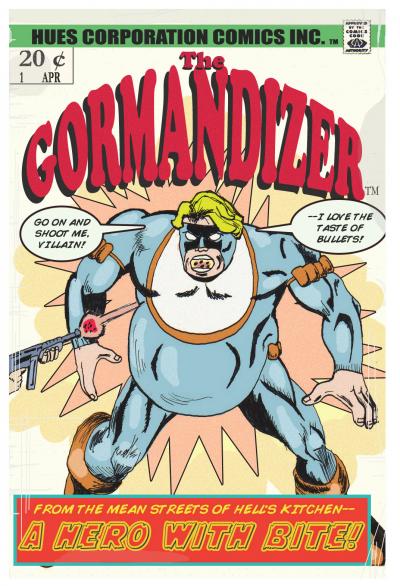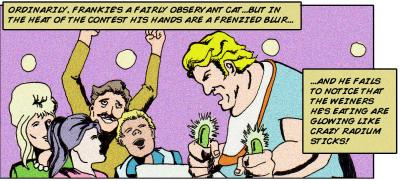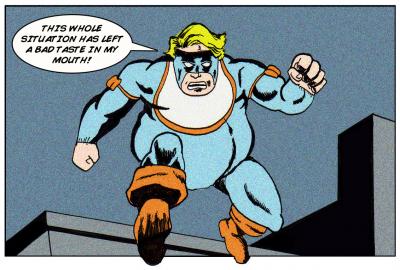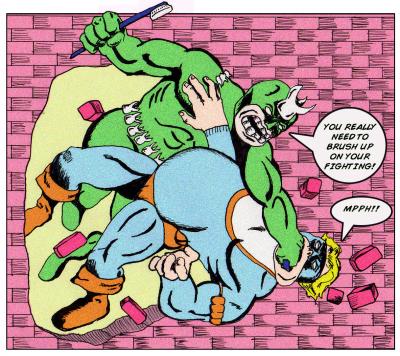

Classic lost comic book of the 1970s: The Gormandizer
During the Bronze Age, a number of publishers attempted to mimic the mainstream success of “the big two,” Marvel and DC. The largest of these — companies like Charlton, Archie, Harvey, Whitman, and Atlas — were able only to make a small dent in the big two’s market share. But one company that popped up in the mid-1970s, Hues Corporation, didn’t necessarily need to grab a big share of the comics market.
That’s because Hues Corporation existed primarily as a way for the “publishers” to launder money made from illegal drug sales in Miami and New York.
Despite the fact that the company had little interest in creating quality comic books, they did manage, during their three-month publishing existence in 1974, to release some interesting and eccentric titles. There was SuperWulf, “The Werewolf with super powers!”; there were The Base Ballers, a professional baseball team that won every game they played, because, of course, they had super powers (which they used to fight crime): there was Senator Secret, a United States senator from New Orleans who had “the power of the Magick,” and managed to fight supernatural crime while still finding time to serve as the ranking minority member of the Senate sub-finance committee; there was The Ochinaut, a man who shrunk himself down to microscopic size and entered people’s bodies to fight “the crimes within us all”; and there was my personal favorite, the hero with “the stomach of steel,” The Gormandizer.

The Gormandizer was Frankie Franklin, a competitive eating champion whose specialty was hot dogs. In the first issue, Frankie accidentally ingests hot dogs that have been irradiated by nuclear waste. Rather than dying of radiation poison, Frankie gets super powers, with the ability to eat anything at all, from nuclear waste to oil, to Twinkies.
Being the owner of an electronics repair shop, this new power serves him well, as he is able to easily dispose of waste that is otherwise regulated by government bureaucrats in the newly-formed EPA. Frankie’s shop becomes the cleanest in the Hell’s Kitchen area of New York City, which leads to some serious questions for the regulators.

In the first issue, Frankie Franklin gets his new powers just before he is abducted by aliens who have selected him to be earth’s champion in an intergalactic eating competition. He has to out-eat representatives of 75 other planets, and the planet of the loser will be destroyed.
The Gormandizer not only doesn’t lose, but he actually wins, eating thousands of living “skunkrabbits.” And thus is born “a hero with bite”!
The Gormandizer was the creation of writer Carrie Pugsky and artist Gary Spieruck. I have no idea if those were their real names, or if they ever worked again in comics; I haven’t been able to find any information on them. In fact, information on the entire publishing venture is difficult to come by — comics fandom is notoriously mercenary, as anyone who’s ever been to a convention like Comic-Con and seen greats from the Golden Age sit in their lonely booths twiddling their thumbs while fanboys line up to get signatures from the latest flash-in-the-pan creators of the modern “event comics” can attest. No one really cares about what happened five years ago, let alone thirty-five years ago.
Anyway, as you can infer from the panel above, Pugsky littered her (his?) writing with late-60s/early-70s argot — there are a lot of “cats,” “chicks,” “babies,” “jazz,” “digs,” and “heps.” There are also some very bad puns, such as when the Gormandizer kicks one of the Toothmaster’s evil dental assistants in the second issue, and declares, “Since my first punch went over so well, here’s a second helping!” This is dated, but in a charming way. Slightly less charming, at least to my eye, is the artwork of Spieruck. He (she?) had much too heavy an inking hand, even for the Bronze Age, in which seemingly every panel of every comic was covered in murky shadow. But he was by no means the worst artist of the decade.

In the second issue, the Gormandizer faced an insane dentist called The Toothmaster. The Toothmaster got his power by stealing people’s teeth; naturally, stealing the super-powered choppers of the Gormandizer would be a real boon to him. It was in this issue that much of the Gormandizer’s lore was established. We learn that his mouth has a sort of gravitational pull so that (as suggested by the cover of the first issue) if someone shoots at him, the bullets always go harmlessly into his mouth, regardless of where the gun was aimed. Also, in order to maintain his strength, the Gormandizer has to eat, which is why he always keeps with him a supply of hot dogs, just in case he’s unable to find any nuclear waste (he is forced to wear his hotdogs on bands around his arms, since his belly is so large that he can’t reach his “utility belt”).
Also, we learn that the Gormandizer isn’t exactly the best-loved of super heroes. He’s made fun of by children for being a “fatty.” In fact, the Toothmaster is seen by the public as the “hero,” while the Gormandizer is reviled, even after he’s able to establish that the Toothmaster was stealing teeth literally from the mouths of babes.

In the third and final issue this idea of the Gormandizer as misunderstood hero is made even more explicit with the appearance of the villainous Lunchlady. The Lunchlady is the wife of a powerful political figure who has taken it upon herself to “reform school lunches,” by replacing the foods that kids like to eat with foods that have been treated with a chemical that turns them into mindless zombies. Her plan is to introduce this tainted food into our general food supply, so that, as is the case with most supervillains, she can take over the world.
Because she presents her tainted food as “healthy alternatives,” most people want to let her do it. But when the Gormandizer discovers her true purpose, he resolves to stop her. And once again, the seemingly overweight superhero is hated for it.
During their battle, the Lunchlady employs her magic ladle, which she uses to transform the Gormandizer’s precious, energy-giving hotdogs into useless carrots. As he weakens, the Lunchlady presses her advantage, and the issue ends on a cliffhanger, with the outcome of the battle in doubt.

With that third issue, dated June 1974 but published April 1974 (comics publishers routinely cover-dated their issues three months ahead), the Gormandizer ceased publication. I’m not sure exactly why the Hues Corporation folded; perhaps it had served its purpose, and laundered enough drug money that it just didn’t need to exist anymore. But I do like to think that the Gormandizer is still out there, somewhere, even if only in the memories of a few (a very few, I am sad to say), collectors of obscure comic books, and that he was finally able to emerge victorious against the Lunchlady, and anyone else who thought it was okay to pick on the overweight.
The images in this review are presented in their fair use context and are not intended to in any way infringe on anyone’s copyright, you dig?
 Print This Post
Print This Post




Happy April Fool’s Day to you, too! :D
Really well done; and once again, brilliant!
Hot damn! And there was me thinking I was the only person who remembered The Gormandizer.
Too many parents threw out too many of their kids’ back issues, and now almost all we have left of these great comics are our memories.